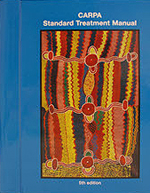 | CARPA Standard Treatment Manual, 5th edition Centre for Remote Health, Alice Springs, NT, Australia, 2010 Language: English Price: AU$60.00 (plus postage) Purchase online from the Centre for Remote Health http://www.crh.org.au/ (at http://www.crh.org.au/content/view/234/87/ |
Publisher's notes
The CARPA Standard Treatment Manual has become the definitive guide for those working in remote primary health care, in the Northern Territory and further afield. It has a strong reputation among its users as an essential tool to support evidence based practice in remote and Indigenous health services. Its 5th edition provides an easily portable manual for AHWs, nurses and doctors, in simple language that does not compromise content. It combines technical expertise with input by remote practitioners for remote practitioners. In producing the 5th edition we have maintained essential components of past manuals, while heeding the recommendations from the 2007 evaluation of the 4th edition.
Review
It was a privilege to review the 5th edition of the CARPA Standard Treatment Manual from my perspective as an experienced rural and now urban GP, with a keen interest to work in remote Aboriginal communities. I am also involved in medical student placements in remote Australia, so I was interested to see if the Manual provides clear and safe guidelines for students, encouraging cultural awareness and sensitive practice. 'Do no harm' are traditional words of encouragement to all clinical practitioners. Does the manual support this in a holistic manner?
The CARPA Manual is already a well established tool for health practitioners, providing a broad range of treatment options for common conditions that a health practitioner might encounter in remote health practice. Since the first edition in 1992, this fifth edition has been updated to provide the most recent, evidence-based guidelines in assessment and management protocols to improve health outcomes for those being served in remote areas.
The Manual is for the use of all primary health practitioners - doctors, nurses and Aboriginal health workers. As someone who has worked in limited capacity in remote health I welcome this easy to read and well formatted book. The cover with a wonderful painting by a practicing ngangkari, Dinny Tjampitjimpa Nolan, set on a vivid blue background makes the book easily identifiable. The manual is hardy in presentation and of a size that is easy to carry and work from, no matter what the physical situation of practice might be. The colour coding for the 6 chapters addressing different content areas will assist any practitioner to access information. Small engaging and helpful pictures on each page represent the conditions being addressed.
Practice in remote Australia is a unique experience and this manual enables one to follow protocols for many clinical situations with clarity. One is often unsupported on the ground and this manual assists by providing clear directives for management, thus increasing the ability of the practitioner to meet the needs of the presenting case and to therefore improve outcomes. The Manual has been revised with input from many remote health practitioners and it presents a unified approach to assessment and management with agreed guidelines for ongoing referral of cases.
The emergency and assessment section provides clear guidelines and clarifies for the practitioner what is important and life saving. This is excellent advice as often the stress of critical interventions can affect clinical decision-making, making these algorithms and pathways of management highly likely to assist. The assessment and intervention flow charts are well set out and coherent. I appreciate the Manual's recognition of the importance of discharge planning in its guidelines, for 'after care' is often crucial to outcomes.
I found the content chapters on child health, mental health and drug problems, chronic diseases and sexual health clearly written, interesting, informative and contributory to best practice in a clinical setting. I have a special interest in palliative care, and found the brief palliative care section provided clear and well balanced information on relevant issues, promoted the need for planning and was culturally sensitive to the wishes of Aboriginal and remote people. As with the many clinical scenarios presented in the Manual, relevant information is presented and highlighted with 'red flags', often enabling the reader and the practitioner to make appropriate decisions with confidence and in a timely fashion.
I appreciate that the CARPA Manual, as a standard treatment manual, has extended treatments to incorporate the community, local support groups, available team management and specialized referral centres. The Manual goes beyond 'hands on' assessment and management, and encourages the practitioner to look at the broader issues involved in the presenting case. Public health issues are raised as well as the need for teaching preventative health strategies as part of the treatment plan.
I have found the situations of remote practice challenging, difficult to tease out, complex and often reflective of larger community issues. The CARPA Manual enables one to simplify the situation, to deal with immediate issues as needed, and then to use established flow charts as an aid to further management and future planned interventions. The Manual is an excellent resource, and in my opinion and is a 'stand alone' tool for all practitioners in remote community health practice.
The Manual has been developed from evidence-based and best-outcome practice, and I can recommend it without hesitation as a grounded and well established educational tool. I encourage all medical students to read it and refer to it on placement. Finally, in answer to my initial question, the Manual is clearly an enabler to each student to 'do no harm'.
Jill Bestic, MBBS, DTMH
Rural Clinical School
Australian National University Medical School
ACT, Australia
